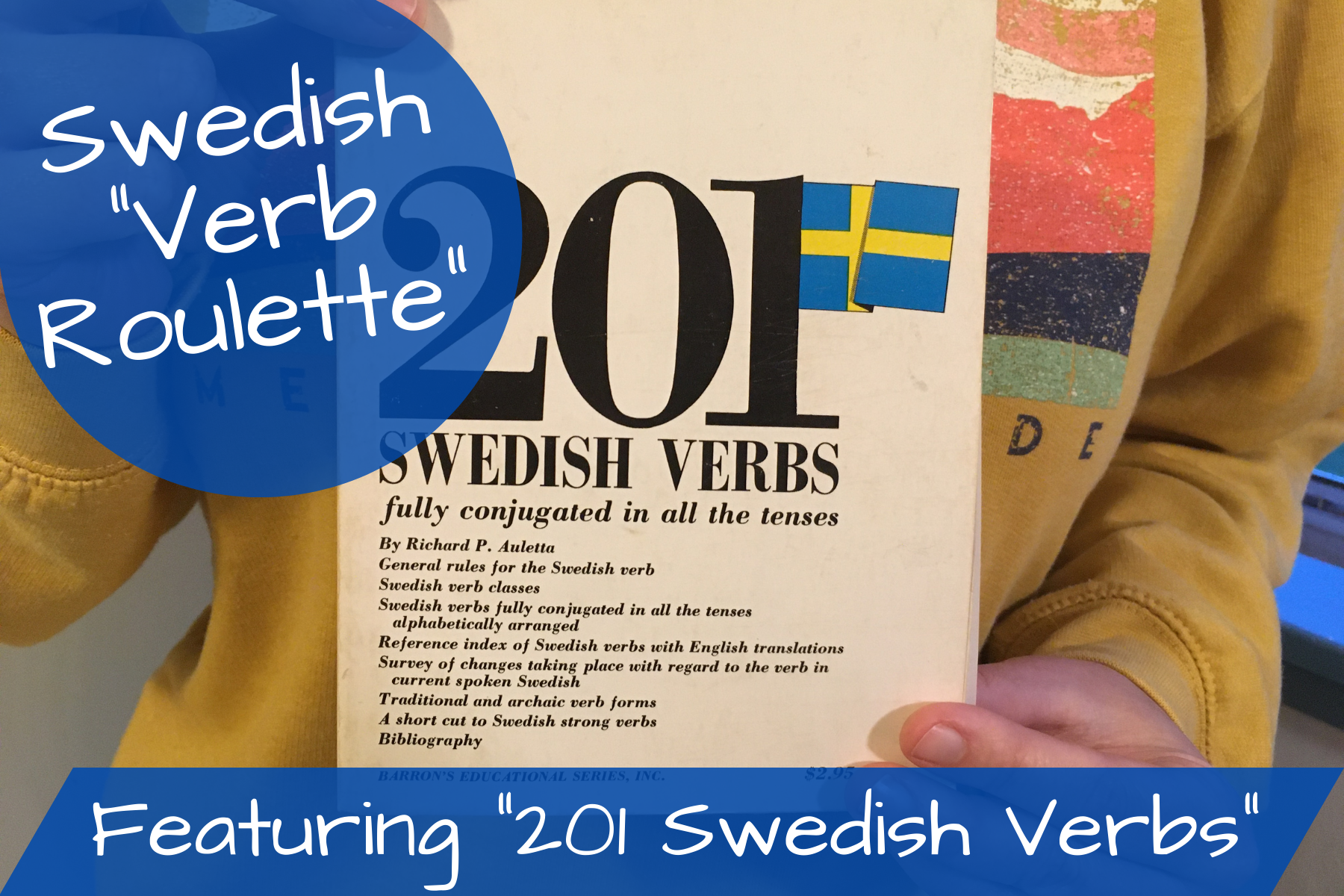Swedish Verb Roulette Featuring “201 Swedish Verbs” Posted by Chelsea B on May 21, 2021 in Grammar, Swedish Language, Uncategorized
“There’s this super amazing book… I don’t know if you’ve heard of it, but it’s called ‘201 Swedish Verbs’ and it’s really great!” Numerous times have these left the peppy lips of my Swedish students. And if you’ve done any searching for Swedish reference material, you’ve most definitely seen this title – many of you probably even own it. It’s by Richard P. Auletta, originally published in 1975, and today, we’re going to use it to play some “Swedish verb roulette.”
201 Swedish Verbs: Fully Conjugated in All the Tenses was published in 1975 by Barron’s Educational Material Series, Inc., and continues to be a solid companion for Swedish learners. Written by Richard P. Auletta, a former foreign language and linguistics professor at Long Island University, and edited by Leif Sjöberg, Germanic and Scandinavian Studies professor at State University of New York, this reference material covers Swedish verbs with English translations and several of their forms, including both modern and more archaic conjugations.
In the book’s foreword, Auletta mentions Swedish as a language “in a state of transition.” He credits World War II for accelerating shifts in the language, particularly in the verb system. For example, the Swedish helping verb skall was almost entirely eliminated from the colloquial speech:
Jag skall baka → Jag ska baka. English: I shall bake.
Additionally, post-war Swedish verbs transitioned into using one form, regardless of singular or plural pronouns. Auletta also mentions the use of “du” in a more widespread fashion, as Swedes stopped addressing folks with their formal titles and last names. Each of the 201 verbs included in the book echo that shift. There are more conjugations of each verb than you would need in modern Swedish, but it’s helpful when reading or listening to older Swedish texts.
Okej! Let’s play what I’m called “Swedish verb roulette.” What is it, you say? I paged through the book, stopping at 7 random pages. Each page details 1 verb, and those 7 verbs in total are listed below. Some of them you will know well, but some of them are a bit more tricky to conjugate. First I’ll include the infinitive form, English translation, and its verb group. In the chart below is imperative, present, past, and present perfect, as well as an example sentence. I’ve included a photo from the text for our first verb so you can see the complexity of the breakdown outlined in the book:
1. att tvätta → to wash verb group 1
| imperative | present | past | present perfect |
| Tvätta! | tvättar | tvättade | har tvättat |
| Wash! | wash/washes | washed | have washed |
Har du tvättat din fotbollströja? Have you washed your soccer (football) jersey?
2. att hinna → to have time verb group 4
| imperative | present | past | present perfect |
| Hinn! | hinner | hann | har hunnit |
| Have time! | have/has time | had time | have had time |
*this one is a little funny because there’s not a great 1-word verb in English for hinner
Förlåt Anna, jag hann inte hämta din bok från biblioteket.
Sorry Anna, I did not have time to pick up your book from the library.
3. att bita → to bite or chew verb group 4
| imperative | present | past | present perfect |
| Bit! | biter | bet | har bitit |
| Bite! | bite/s | bit | have bitten |
Vad gjorde mannen innan hunden bet honom?
What did the man do before the dog bit him?
4. att svälta → to starve, intransitive verb group 4
| imperative | present | past | present perfect |
| Svält! | svälter | svalt | har svultit |
| Starve! | starve | starved | have starved |
Om man får för lite mat, då kan man svälta.
If one gets too little food, then one can starve.
5. att sträcka → to stretch verb group 2b
| imperative | present | past | present perfect |
| Sträck! | sträcker | sträckte | har sträckt |
| Stretch! | stretch/es | stretched | have stretched |
Alperna sträcker sig* från Italien till Tyskland.
The Alps stretch from Italy to Germany.
*I used the reflexive form sträcker sig, but the conjugations are the same for this verb, too!
6. att gripa → to grip, to capture verb group 4
| imperative | present | past | present perfect |
| Grip! | griper | grep | har gripit |
| Grip! | capture/s | captured | have captured |
De grep gruppen som var misstänkt för bombhotet.
They captured the group that was suspected of the bomb threat.
7. att vrida → to turn, twist verb group 4
| imperative | present | past | present perfect |
| Vrid! | vrider | vred | har vridit |
| Twist! | twist/s | twisted | have twisted |
So, who else owns this book? If you love verbs and grammar like I do, definitely pick up a copy. It’s widely available with most online book retailers. Bonus points go to anyone who writes an example sentence in the comments, go!
Sources:
Auletta, Richard P. (1975). 201 Swedish Verbs: Fully Conjugated in All the Tenses (L. Sjöberg, Ed.). Barron’s Educational Material Series, Inc. Woodbury, New York.

Build vocabulary, practice pronunciation, and more with Transparent Language Online. Available anytime, anywhere, on any device.






Comments:
Mark Beckstrom:
I have the book and look at it occasionally.
What I miss is the chance to use Swedish in conversation. My maid way of keeping up and improving the Swedish I have is thru Duolingo where I’m the intermediate level.